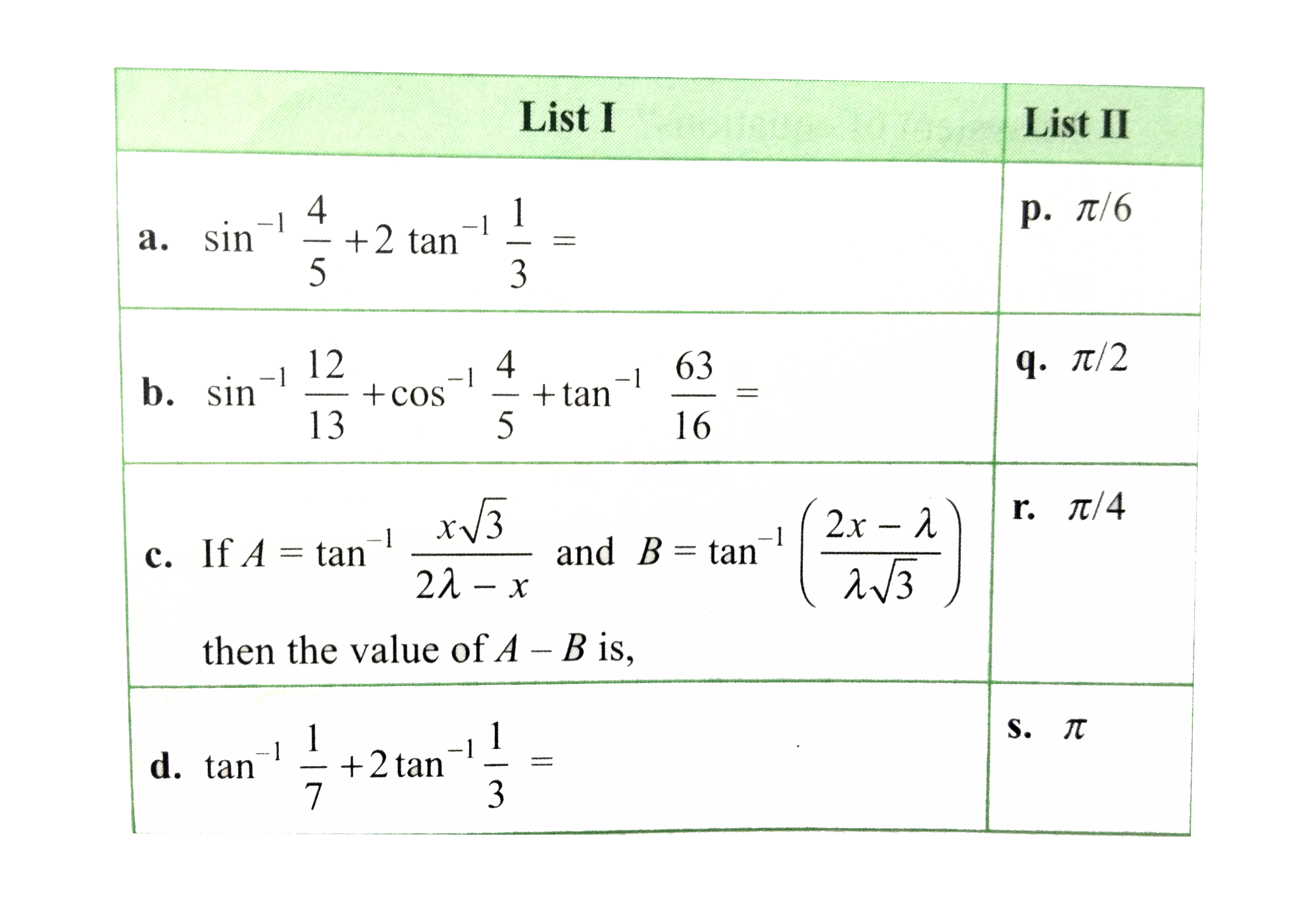If 0<cos−1(x)<1 and 1+sin(cos−1x)+sin2(cos−1x)+sin3(cos−1x)+∞=2 then the value of 12x2 is____
The correct Answer is:9
1+sin(cos−1x)+sin2(cos−1x)+...∞=2
⇒11−sin(cos−1x)=2
or 12=1−sin(cos−1x)
or sin(cos−1x)=12
or sin(cos−1x)=12
or cos−1x=π6
or x=√32 or 12x2=9
Topper's Solved these Questions
- INVERSE TRIGONOMETRIC FUNCTIONSBook:CENGAGE ENGLISHChapter:INVERSE TRIGONOMETRIC FUNCTIONSExercise:Archives (JEE MAIN)
Explore 2 Videos
- INVERSE TRIGONOMETRIC FUNCTIONSBook:CENGAGE ENGLISHChapter:INVERSE TRIGONOMETRIC FUNCTIONSExercise:Archives (JEE Advanced)
Explore 1 Video
- INVERSE TRIGONOMETRIC FUNCTIONSBook:CENGAGE ENGLISHChapter:INVERSE TRIGONOMETRIC FUNCTIONSExercise:Matrix match type
Explore 8 Videos
- INTRODUCTION TO VECTORS Book:CENGAGE ENGLISHChapter:INTRODUCTION TO VECTORS Exercise:MATRIX-MATCH TYPE
Explore 3 Videos
- JEE 2019Book:CENGAGE ENGLISHChapter:JEE 2019Exercise:Chapter 10
Explore 9 Videos
Similar Questions
If x, y, z are in A.P. and tan−1x,tan−1yandtan−1z are also in A.P. then show that x=y=z and y≠0
View SolutionThe value of cot(23∑n=1cot−1(1+n∑k=12k)) is (a) 2325 (b) 2523 (c) 2324 (d) 2526
View SolutionMatch the following List I to List II

View SolutionRefer to the following diagram :

Column IColumn IIa.Collinear vectorsp.→ab.Coinitial vectorsq.→bc.Equal vectorsr.→cd.Unlike vectors (same initial point)s.→d
View SolutionIf y = y(x) is the solution of the differential equation, xdydx+2y=x2 satisfying y(1) = 1, then y(12) is equal to
View SolutionIf 0<cos−1x<1and1+sin(cos−1x)+sin2(cos−1x)+sin3(cos−1x)+∞=2, then the value of 12x2 is____.
View Solution∫2sinx(3+sin2x)dxisequa<o 12ln∣∣∣2+sinx−cosx2−sinx+cosx∣∣∣−1√2tan−1(sinx+cosx√2)+c 12ln∣∣∣2+sinx−cosx2−sinx+cosx∣∣∣−12√2tan−1(sinx+c0sx√2)+c 14ln∣∣∣2+sinx−cosx2−sinx+cosx∣∣∣−1√2tan−1(sinx+c0sx√2)+c noneofthese
View Solution1- (sin ^ (2) x) / (1 + cos x) + (1 + cos x) / (sin x) - (sin x) / (1-cos x) =
View SolutionFind the area bounded by the curves y=(sin^(-1)(sin x)+cos^(-1)(cos x)) and y=(sin^(-1)(sin x)+cos^(-1)(cos x))^(2) for 0<=x<=2 pi
View SolutionLet f1(x)=sin−1(cos(sin2x)),f2(x)=cos−1(sin(cos2x)),f3(x)=sin−1(cos(cos2x)),f4(x)=cos−1(sin(sin2x)) .Then which of the following is/are correct?
View Solutionprove that ,sin−1cossin−1x+cos−1sincos−1x=π2
View Solution{cos(sin−1x)}2={sin(cos−1x)}2
View SolutionIf 0<cos−1x<1 and 1+sin(cos−1x)+sin2(cos−1x)+sin3(cos−1x)+.....∞=2 then x equals
View SolutionConcrete is produced form a mixture of cement, water and small stones. Small amount of gypsum, CaSO4.2H2O is added in cement production to improve the subsequent hardening of concrete. The elevated temperature during the production of cement may lead to the formation of unwanted hemihydrate CaSO412H2O according to reaction.
CaSO42H2O(s)→CaSO412H2O(s)+32H2O(g)
The ΔfHΘofCaSO2.2H2O(s),CaSO412H2O(s),H2O(g)
are −2021.0kJmol−1,−1575.0kJmol−1 and −241.8kJmol−1, respectively. The respective values of their standard entropies are 194.0,130.0 and 188.0JK−1mol−1. The values of R=8.314JK−1mol−1=0.0831L bar mol−1K−1.
Answer the following questions on the basis of above information.
Heat change occurring during conversion of 1kg of CaSO4.2H2O(s) (molar mass 172gmol−1) of CaSO412H2O(s) is equal to
View SolutionIf 0<cos−1x<1and1+sin(cos−1x)+sin2(cos−1x)+sin3(cos−1x)+…∞=2, then the value of 12x is
View SolutionIf 0<cos−1x<1 and 1+sin(cos−1x)+sin2(cos−1x)+sin3(cos−1x)+…….∞=2, then the value of 12x2 is
View Solution
